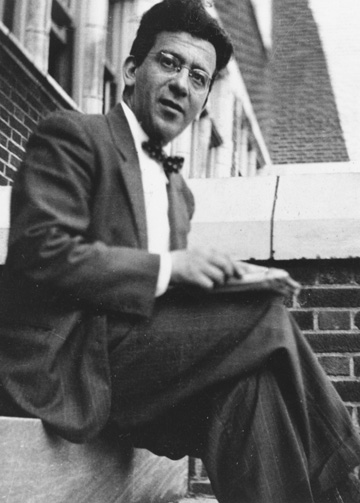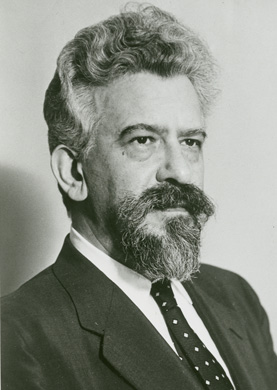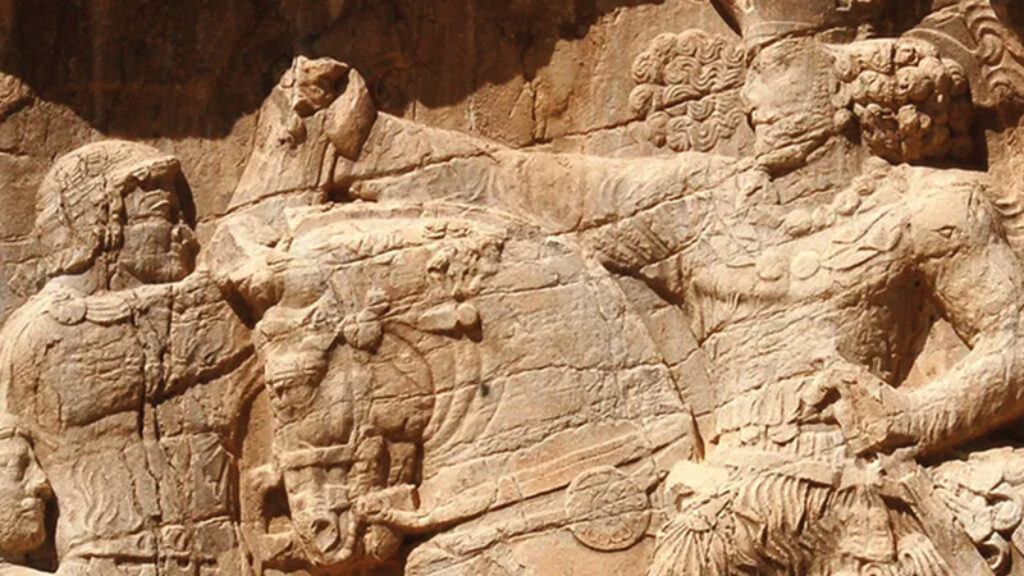Heschel Transcendent
In the fall of 1942 Mordecai Kaplan was reading The Review of Religion when he ran across a philosophical account, from the inside as it were, of religious piety. Kaplan was so struck with it that, his biographer Mel Scult tells us, he wrote a kind of free verse prayer-précis called “The Pious Man” in his journal:
Let us observe the pious man and probe into his soul.
We shall discover in it that which transcends man,
That which surmounts the visible and the available,
Steadily preventing him from immersing himself in sensation or ambition,
From yielding to passion or slaving for a career.
For him life takes place amid horizons beyond the span of years.
…
Faith engages a man’s mind;
Piety, his entire life.
Kaplan was, perhaps, too much of a Deweyan pragmatist to be much of a poet, but he did have an eye for talent.

Abraham Joshua Heschel, the author of “An Analysis of Piety,” was a 35-year-old émigré scholar—Hasidic-born and University of Berlin-trained—who had been saved from the Nazis by a last-minute visa and job from the Hebrew Union College and its heroically enterprising president, Julian Morgenstern. Kaplan was perceptive, too, in seeing the centrality of the idea of transcendence—of religion as a striving for something beyond human experience and the natural world—to Heschel, particularly since it was the opposite of Kaplan’s own this-worldly Judaism. “Faith,” Heschel would later write in God in Search of Man, “is an act of man who transcending himself responds to Him who transcends the world.”
It is in fact just this ideal of transcendence around which Shai Held organizes his thoughtful, illuminating new study of Heschel’s thought. Held’s book is what philosophers and intellectual historians sometimes call a “rational reconstruction.” Held does not follow the trajectory of Heschel’s career or take up key texts individually, but rather presents a picture of his thinking as a whole. Heschel, he says, was not a “linear writer,” but he was a lucid, coherent thinker whose system can be explicated by collating and interpreting widely separated passages: “a stray thought here and a seemingly irrelevant line there may provide crucial insight not articulated or adequately expressed in its proper place.”
This method has its limits (to which I shall return), but it can also be invaluable, and it is especially so in Heschel’s case. Unlike his intellectual peers, a group that might be said to include Rabbi Joseph B. Soloveitchik, Reinhold Niebuhr, the Lubavitcher Rebbe, and Emmanuel Levinas, Heschel is often treated as something more like a religious poet than a theologian. I remember David Hartman visiting the UCLA Hillel in the 1980s and saying, with evident respect and affection, “Heschel wouldn’t know an argument if it hit him in the head,” (some have felt the same about Hartman). To be fair, Heschel’s seemingly inexhaustible reservoir of eloquence did not always serve him well in this regard. Even God in Search of Man, the book to which Held devotes the most attention, reads as much like a series of thematically linked prose poems (or derashot) as it does systematic theology. Certainly, Heschel could become too enamored of turns of phrase (“After all, philosophy was made for man rather than man for philosophy,” he says early on in Who Is Man?—Well, one is tempted to respond, who could possibly claim otherwise or ever has?). But, as Held demonstrates, he was a deep and original thinker who remains relevant.
“Piety,” Heschel had written in the 1942 The Review of Religion essay, “points to something beyond itself.” Eleven years later he told a story about his spiritual struggles as a young man at the annual conference of the Reform movement (Heschel himself had since moved to the Conservative movement’s Jewish Theological Seminary, but he was never much of a movement man):
I walked alone in the evenings through the magnificent streets of Berlin . . . Suddenly I noticed the sun had gone down, evening had arrived.
From what time may one recite Shema in the
evening?
I had forgotten God—I had forgotten Sinai—I had forgotten that sunset is my business—that my task is “to restore the world to the kingship of the Lord.” So I began to utter the words of the evening prayer . . . And Goethe’s famous poem rang in my ear:
Über allen Gipfeln ist Ruh’
O’er all the hilltops is quiet now
No, that was pagan thinking. To the pagan eye the mystery of life is Ruh’, death, oblivion. To us Jews, there is meaning beyond the mystery. We should say
O’er all the hilltops is the word of God . . .
How grateful I am to God that there is a duty to worship, a law to remind my distraught mind that it is time to think of God, time to disregard my ego for at least a moment!
Although Held does not quote this particular passage, Heschel’s insight that the “yoke of the commandments,” and in particular the obligation to pray, entails a rejection of the ego is central to Held’s interpretation. “Self expression,” he writes in description of Heschel’s position, “is achieved, paradoxically, by paying less rather than more attention to myself, by shifting the center of my consciousness toward God and away from myself.” Indeed, as Held goes on to show, for Heschel the most important kind of prayer is one that is not really self-expression at all but rather “an act of empathy”:
The person does not approach the liturgy in a “prayerful mood,” but instead allows the words to direct him, to elicit a set of reactions from him. If, in the former case, human passions precede the act of prayer, in the latter case they follow upon them.
“The art of prayer” is, Heschel wrote in a passage Held scrutinizes closely, “in the absence of self-centered thoughts.” This is not to say that Heschel held out the possibility of a complete emptying of consciousness and mystical union, or devekut, between even the artful davener and God. Here and elsewhere—especially in his many discussions of prophecy—Heschel insists on the preservation of human individuality. The human soul does not dissolve without remainder into the divine ocean, as some mystics would have it.

Held is entirely right to emphasize that this is Heschel’s position and cogent, too, in his contextualization of it within Heschel’s broader theology. However, this is one of a few instances in the book where one wishes that it was not quite so pure an exercise in rational reconstruction. For Held goes on to compare Heschel’s position with that of the influential early-20th-century scholar of mysticism Evelyn Underhill and the famous mid-century American Trappist Monk Thomas Merton, both of whom coupled “self-transcendence with mystical union.” And yet, as Held well knows, Underhill and Merton’s positions might be useful analytic counterpoints to Heschel, but they weren’t his reference points. (It is true—though Held doesn’t mention it—that Heschel and Merton corresponded in the years leading up to Vatican II. Heschel even visited Merton at his Kentucky monastery, but as far as I know they never discussed these issues.)
The question of whether the human soul can achieve compete union with God has a complicated double history, and Heschel had a part in both halves of it. The dominant position within pre-modern Jewish mysticism and philosophy was that although one can aspire to cleave to God, one cannot aspire to merge with Him. The great 20th-century historian of Kabbalah, Gershom Scholem, argued that this was really the only position, but, as Moshe Idel has definitively shown, he was wrong. Moreover, it was within the Hasidic movement, to which Heschel was heir, that the aspiration toward a complete mystical union reemerged in the modern period. Finally, Martin Buber, with whom Heschel had a complicated personal and professional relationship (as, of course, did Scholem), denied precisely this in presenting Hasidism as embodying his I-Thou philosophy of dialogue, in which God is the “Eternal Thou,” with whom one can never unite.
It would take more than a few pages to unpack all of this (some of it is alluded to in Held’s footnotes), but doing so would show how Heschel stood at the intersection of these theological traditions and scholarly conversations. Held is an invariably sensitive and deeply serious reader, but there is a sense here that what is being described is a set of alternative positions on a theological game board, though for both Held and his subject the stakes are, and ought to be, much higher.
One of the joys of Held’s book is reading his long discursive endnotes, terse mini-essays in 10-point type that would have been even better, and certainly more rabbinic, as true footnotes at the bottom of the page (academic presses have their reasons—and their budgets). One example comes in a discussion of how Heschel’s insistence that a person’s prayer is ideally not about him or herself is in tension with the rabbinic emphasis on the amida prayer, “with its manifold petitions” for protection, forgiveness, health, and redemption. In the accompanying footnote he quotes Heschel’s contemporary Joseph Soloveitchik to the opposite effect: “Since prayer flows from a personality which finds itself in need . . . its main theme is not praise or adoration but rather request, demand, supplication.” As Held puts it, for Soloveitchik “the goal of prayer is not to forget the self entirely, but rather to surrender illusions of self-sufficiency, to become more deeply aware of [our] dependence upon God.” Held doesn’t attempt to resolve the issue between these two great 20th-century figures, nor does he succumb to the temptation to reduce it to a case of liberalism versus orthodoxy or hasidut versus mitnagdut. He simply highlights the issue and moves on.
Abraham Joshua Heschel: The Call of Transcendence illuminates its subject’s thought on many other issues, including the human experience of wonder, the possibility of revelation, and the pathos of God. On all these issues and more, it will become a touchstone of future discussions. I have focused on its treatment of prayer because it is central to Heschel’s insight that the transcendent God of Judaism calls upon us to transcend ourselves.
After reading his “Analysis of Piety,” Mordecai Kaplan had hoped that Heschel would come to JTS. Heschel came in 1945, and Kaplan inserted his versification of the article in his radical new prayer book, but their approaches were too different for the two men to be intellectual allies. When Heschel later lamented that it was not “the Psalmist, Rabbi Jehudah Halevi, Rabbi Isaiah Horovitz, or Rabbi Nahman of Bratslav . . . who has become our guide in matters of Jewish prayer and God,” but Hegel, Dewey, and Freud, he was probably thinking of Kaplan. It is one of the many virtues of Shai Held’s book that it helps us to place Heschel alongside not only Kaplan but Halevi, Horovitz, and Rav Nahman—as well as the Psalmist.
Comments
You must log in to comment Log In
Suggested Reading

Imperial Rabbis
What, exactly, was Babylonian about the Babylonian Talmud and its sages?A new book by Simcha Gross suggests a radically new understanding.
The Other Bernstein
Late August 2018 marks the 100th anniversary of Leonard Bernstein’s birth and the first Yahrzeit of his brother, Burton, who wrote an incredible family memoir.
Journeys Without End
For some three decades Lionel and Diana Trilling shared a limelight that was not quite identical but never entirely separate.
The Problem Is Not Ideological
Noah Benjamin Bickart of The Jewish Theological Seminary teaches Jews who are passionate about “an egalitarian, halakhic, yet non-fundamentalist Judaism,“ even though they may not call themselves Conservative Jews.
gwhepner
This comment is inspired not only by Abraham's Socher's article on Abraham Joshua Heschel by but by Rabbi Lord Jonathan Sacks's review of Terry Eagleton's Culture and the Death of God:
NOSTALGIA FOR THE NUMINOUS
Nostalgia for the numinous,
like chewing cud in rumen is,
for Jews a signal that they wish
to be a kosher fleshy dish,
appropriate for the consumption
of other Jewish people whose presumption
is that for others of their ilk
nostalgia is like mother’s milk,
chewing over just like cud
the numinous that’s in their blood.
Cows, of course, have few defendants
among those who are craving beef,
and a yearning for transcendence
may belie banal belief.
[email protected]
charles.hoffman
Abraham Joshua Heschel z"l was a Chassidic Rebbe with a two-piece suit; his popular material should be read in light of the message of chassidus - achieving a relationship with God at the personal level. When viewing "Man in Search" from afar, its message seems a bit obscure; however, when experiencing it and his other "popular" books up close, one gets the sense of an old chassidic rebbe sitting with his group of followers in the quiet of late afternoon Shabbat and sharing with them a few thoughts for their further reflection.
And then, with a finely-honed sabre and a blockbuster encyclopedic barrage, he overwhelms the reader with "Torah min Hashamayim" - later translated as "Heavenly Torah". The same quiet little voice - that kol d'mmama daka - could shout from the rooftops on the eternal truth of the revelation at Sinai.
may his memory be a blessing for all
chaim01
I would like some clarification. For AJH was all formal prayer essentially the same enabling the closeness with God, or is there is difference between the particular words of specific prayers? Are pesuka dezimra a greater catalyst to bringing one closer to God than shmonah esreh or is the content irrelevant? In other words do the specific words work in different ways to bond with God, or is it the prayer experience itself that does it?